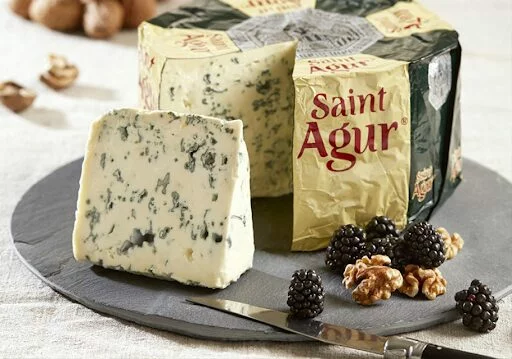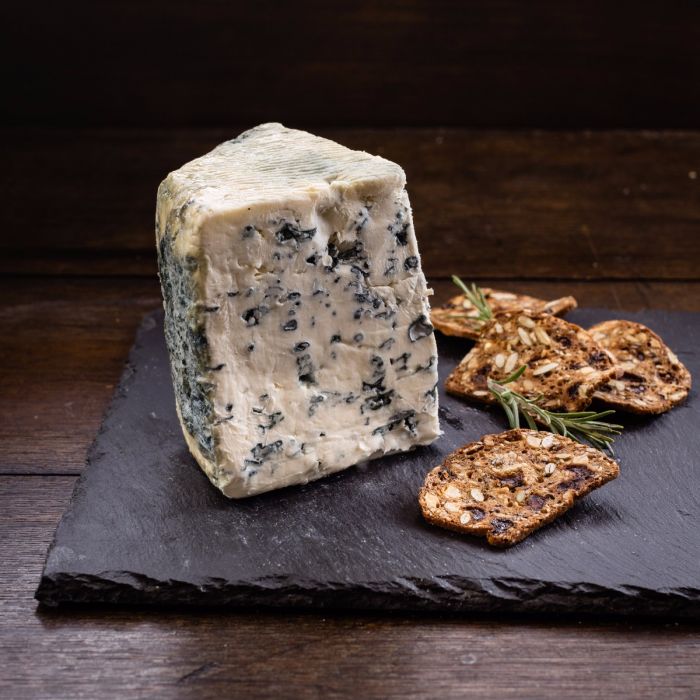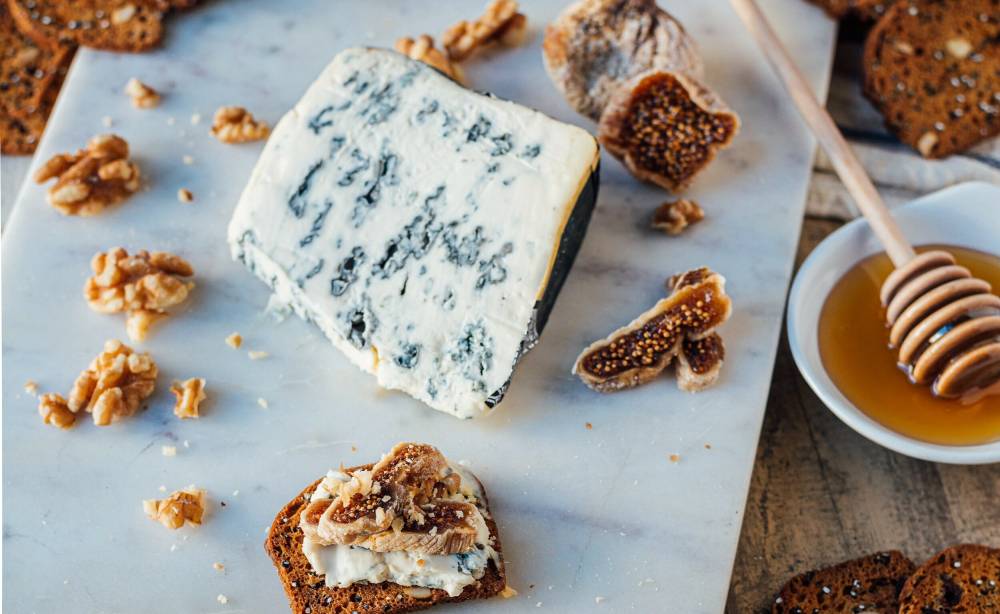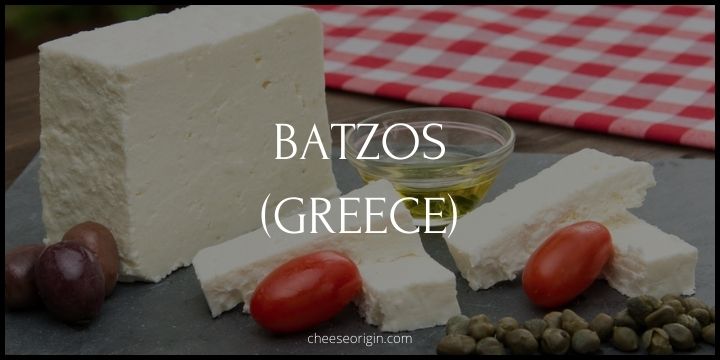What is Saint Agur? The Creamy Blue Treasure from Auvergne

In the heart of France’s verdant Auvergne region, nestled between volcanic peaks and vast plateaus, a culinary treasure is crafted with time-honored tradition and meticulous care. This isn’t just any cheese, but Saint Agur, a seductively creamy blue cheese that has captivated palates across the globe.
This delicacy, with its trademark blue veins and luscious creaminess, stands as a testament to French cheesemaking excellence. If you’re a cheese enthusiast or a curious foodie ready to embark on a gastronomic journey, join us as we delve into the world of Saint Agur.
Quick Facts About Saint Agur
| Quick Fact | Details |
|---|---|
| Origin | Originates from the village of Beauzac in the Monts du Velay, part of Auvergne, central France. |
| Type | A blue cheese made from cow’s milk. |
| Texture | Has a creamy and buttery texture, which is more spreadable than crumbly. |
| Taste | Has a unique, intense flavor. It’s rich and creamy with a mild spicy note. |
| Production | It’s a double-cream cheese, meaning cream is added during its production, resulting in a high fat content (usually over 60%). |
| Aging | The cheese is aged for at least 60 days. |
| Shape | Typically sold in a distinctive octagonal shape. |
| Pairing | Pairs well with fruits like pears and apples, nuts, and sweet wines. |
| Availability | Available all year round. |
| Vegetarian | Not suitable for vegetarians as it uses animal rennet in production. |
| Nutritional Value | High in protein and calcium, but also high in fat and sodium. |
| Storage | Best stored in the fridge, wrapped in foil or wax paper to maintain moisture. |
| Serving | Often served on cheese boards, in salads, or melted in cooking. |
| Rind | The rind is edible but can be strong in flavor. Some prefer to remove it. |
What is Saint Agur?

Saint Agur is a culinary gem from the heart of France, specifically from the village of Beauzac in the Monts du Velay, a part of the mountainous Auvergne region. This region is renowned for its production of blue cheese, which has been a local tradition for centuries.
Saint Agur is a blue cheese made with pasteurized cow’s milk, set apart by its distinctive blue veins resulting from the fungi Penicillium roqueforti. But what makes Saint Agur truly unique is its richness. With 60% butterfat, it qualifies as a double-cream cheese, a testament to its indulgent nature.
The taste of Saint Agur is an experience in itself. It combines the rich, intense flavor typical of blue cheeses with a unique creamy texture that simply melts in your mouth. Whether it’s savored on its own, melted on a burger, or used to create special cheesy sauces, Saint Agur brings a touch of French luxury to any dish.
In addition to its classic form, Saint Agur also comes as a soft, dippable crème, offering another way to enjoy its rich and creamy goodness. All these attributes make Saint Agur not just a cheese, but a unique and authentic representative of French cheese-making expertise.
What Does Saint Agur Taste Like?
Saint Agur is known for its creamy, buttery texture and intense taste. The flavor is a combination of the rich, full-bodied creaminess from the added cream during production and the sharp, slightly spicy tang that is characteristic of blue cheeses.
Despite its intensity, Saint Agur is milder and less salty compared to other blue cheeses, making it a good entry point for those new to this type of cheese. Its luxurious creaminess helps to balance out the strong, pungent flavors typical of blue-veined cheeses, resulting in a smooth, melt-in-your-mouth experience.
The flavor also has a subtle sweetness, which pairs well with fruits like pears and apples, as well as sweet wines. So, while Saint Agur is bold and distinctive, it’s also incredibly versatile, enhancing a wide variety of dishes or simply enjoyed on its own.
Saint Agur Tasting Notes

- Texture: Saint Agur is known for its creamy and buttery texture. Unlike some blue cheeses, it’s more spreadable than crumbly, which makes it great for spreading on crackers or melting into sauces.
- Flavor: The cheese has a rich and intense flavor, combining the creaminess of double-cream cheeses with the sharp, tangy notes typical of blue cheeses. Despite its intensity, it’s milder and less salty than many blue cheeses.
- Blue Veins: The distinctive blue veins running through the cheese contribute a slight spiciness to its overall flavor profile.
- Sweetness: There’s a subtle sweetness to Saint Agur, which helps balance out its strong flavors and pairs well with fruits like pears and apples, as well as sweet wines.
- Creaminess: With a fat content of over 60%, Saint Agur is a double-cream cheese. This contributes to its luxurious, melt-in-your-mouth texture and rich flavor.
- Rind: The rind of Saint Agur is edible but can be strong in flavor. Some people prefer to remove it before eating.
- Aftertaste: Saint Agur leaves a lingering creamy aftertaste with a hint of spice. This makes it great for savoring slowly, either on its own or as part of a cheese board.
Is Saint Agur the Same as Roquefort in Terms of Flavor and Taste?
While Saint Agur and Roquefort are both blue cheeses, they are not the same in terms of flavor and taste.
| Saint Agur | Roquefort | |
|---|---|---|
| Origin | France | France |
| Milk Used | Cow’s milk | Sheep’s milk |
| Texture | Creamy, buttery, spreadable | Crumbly yet somewhat moist |
| Flavor | Mild, tangy, creamy with a hint of sweetness | Strong, robust, and tangy with a slightly sweet aftertaste |
| Blue Veins | Prominent, contributing to a mild spiciness | Prominent, contributing to the cheese’s pungency |
| Fat Content | High (over 60%) due to being a double-cream cheese | Lower than Saint Agur, but still high (around 50%) |
| Ageing Process | Aged for 60 days | Aged for about five months in natural, humid caves |
| Pairings | Pairs well with fruits like pears and apples, nuts, pickles, and sweet or full-bodied wines | Traditionally paired with strong red wines, figs, and crusty bread |
| Best For | Those who prefer a milder, creamier blue cheese | Those who love a strong, robust flavor |
>> Click here to read our in-depth guide on Roquefort
How Strong is Saint Agur Compared to Other Popular Blue Cheeses?
| Saint Agur | Danish Blue | Gorgonzola | Stilton | |
|---|---|---|---|---|
| Country of Orgin | France | Denmark | Italy | England |
| Texture | Creamy, buttery, spreadable | Semi-soft, creamy | Soft, crumbly, and slightly grainy | Crumbly, slightly creamy |
| Flavor | Mild, tangy, creamy with a hint of sweetness | Mild to strong, salty, and sharp | Mild, sweet, slightly nutty | Rich, robust, slightly sweet |
| Fat Content | Over 60% | 25-30% | Around 48% | Around 35% |
| Aging Process | Aged for 60 days | Aged for 8 to 12 weeks | Aged for 50 to 90 days for Dolce variety and up to four months for Piccante variety | Aged for nine weeks or more |
How to Eat Saint Agur Cheese Like a Pro

- Temperature Matters: For the best flavor, take Saint Agur out of the fridge about an hour before you plan to eat it. This lets it come to room temperature and enhances its creamy texture and rich flavor.
- Pairing with Bread: Saint Agur pairs well with a variety of breads. Try it with a crusty baguette, whole grain toast, or even sweet fruit and nut bread for a delightful contrast.
- Fruit Companions: The creamy, tangy flavor of Saint Agur goes well with fresh fruits. Pears, apples, and grapes can balance out the richness of the cheese. Dried fruits like figs or dates can also be a good match.
- Wine Pairing: When it comes to wine, opt for a sweet white like a Sauternes or a full-bodied red like Cabernet Sauvignon or Merlot. The sweetness or robustness of these wines can complement the tangy flavor of Saint Agur.
- Cheese Board Addition: Include Saint Agur in your cheese board. It adds a nice contrast to hard cheeses and its creamy texture makes it a crowd-pleaser. Don’t forget to include some plain crackers to let the flavor of the cheese shine.
- In Cooking: Saint Agur can also be used in cooking. Its creaminess lends itself well to sauces, dressings, pasta dishes, or melted over a steak.
- Savor Every Bite: Most importantly, take the time to savor every bite. Notice the creamy texture, the tangy flavor, and the slight spice from the blue veins. Enjoying Saint Agur is about appreciating the complexity and depth of its unique characteristics.
10 Best Saint Agur Substitutes
| Cheese | Reason for Substitution |
|---|---|
| Roquefort | Made from sheep’s milk like Saint Agur, Roquefort offers a strong, tangy flavor that can mimic the uniqueness of Saint Agur. |
| Fourme d’Ambert | This milder blue cheese is creamier than Saint Agur but can still provide a similar taste and texture. |
| Cabrales | Cabrales has a strong flavor and creamy texture that can stand in for Saint Agur in many recipes. |
| Bleu d’Auvergne | This cheese is less creamy but has a strong blue flavor that can replace Saint Agur. |
| Fromager d’Affinois Blue | This double-cream cheese is very creamy and mild, making it a good substitute if you want something less intense than Saint Agur. |
| Pata Cabra Cheese | Pata Cabra is a semi-soft, creamy cheese with a mild flavor that can work as a substitute for Saint Agur in certain dishes. |
| Fontina | Fontina is a semi-soft cheese with a mild flavor and slightly nutty taste. It can be used as a Saint Agur substitute in recipes where a less pungent flavor is desired. |
| Limburger | Limburger is a soft cheese with a very strong smell and flavor, making it a good substitute for the boldness of Saint Agur. |
| Reblochon | Reblochon is a semi-soft cheese with a creamy texture and nutty flavor. It could serve as a milder, less pungent alternative to Saint Agur. |
| Chaumes | This cheese is soft and creamy with a strong flavor, making it a potential substitute for Saint Agur. |
What Pairs Well With Saint Agur?

Food that goes well with Saint Agur:
| Category | Food Items |
|---|---|
| Bread | Crusty French baguette |
| Fruits | Pears, Figs |
| Nuts | Walnuts |
| Meat | Grilled steak, Pork dishes |
| Vegetables | Roasted Red Cabbage |
| Snacks | Crackers |
| Desserts | Canapés, Mini Sandwiches, Mince Pies |
Also read: 11 Best Crackers that Pair Well with Cheese
Beverage that goes well with Saint Agur:
| Category | Beverage |
|---|---|
| Wine | Sauternes, Cabernet Sauvignon, Merlot |
| Beer | Stout, Porter, Belgian Trappist beers |
| Whiskey | Scotch, Irish whiskey |
| Non-Alcoholic | Sparkling water, Grape juice |
Also read: Best Wine and Cheese Pairings: The Ultimate Guide
Frequently Asked Questions
1. How to pronounce St Agur?
The correct pronunciation of “St Agur” in French is “Sahn-t Ah-gur”. The “t” in Saint is silent and the “gur” in Agur is pronounced like “grr”. Remember, pronunciation can vary slightly based on regional accents.
2. Is St Agur a soft cheese?
Yes, Saint Agur is considered a soft cheese. It’s a blue-veined cheese made from pasteurized cow’s milk that combines the rich taste of blue-veined cheese with a unique creamy texture that melts in your mouth.
3. How long does St Agur last?
Saint Agur cheese should ideally be consumed within 3 to 4 weeks after it’s opened, provided it’s stored properly. Unopened, it can last up to 8 weeks if refrigerated.
To store Saint Agur, wrap it in wax paper or parchment paper and then loosely in plastic wrap or place it in a sealed plastic container. This allows the cheese to breathe while still maintaining a moist environment. The cheese should be kept in the coolest part of the refrigerator, typically the vegetable drawer.
Remember, if you see any mold growth on the cheese that is not the characteristic blue veining, it’s best to discard it.
Also read:
- What is Saganaki? The Greek Culinary Star
- What is Cheddar Jack? The Art of Cheese Blending
- What is String Cheese? Everything You Need to Know
- What is Chihuahua Cheese? Mexican Cuisine’s Best Kept Secret
- What is Buche de Chevre? A French Culinary Treasure
- What is Fromage Frais? A French Culinary Gem Explained
- What is Ouleout? A Tale of Taste and Turmoil




